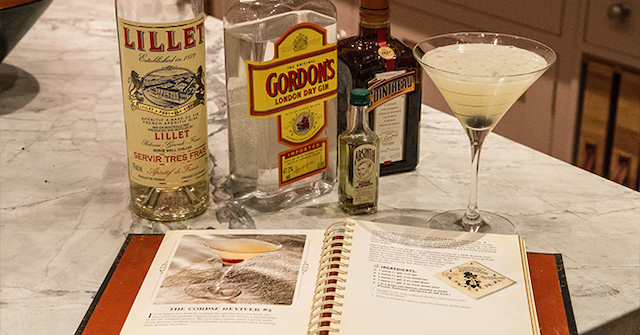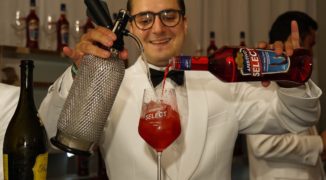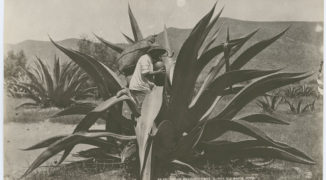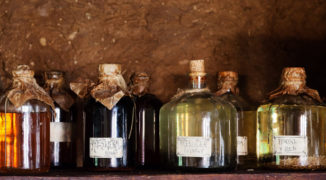When you hear “Corpse Reviver,” your mind likely travels to the Corpse Reviver #2 from Harry Craddock’s “The Savoy Cocktail Book.” But if you were speaking colloquially in the late 19th and early 20th centuries, asking for a corpse reviver was equivalent to telling your friends you’d spent the previous evening out on the town.
In 1889, a charming slang dictionary describes a “Corpse-reviver” as “a dram of spirits” with an example of usage from The Sporting Times: “There was a general rush for wet towels and corpse-revivers.” The term covered a very diverse group of mixed drinks, mostly intended to be hair of the dog remedies. Usage can be seen as early as 1861 in London’s Punch magazine.
There are mentions of layered Corpse Reviver drinks (including such ingredients as creme de noyau, maraschino, and yellow chartreuse) said to be on Parisian menus by 1863, but the first Corpse Reviver recipe appears to be from “The Gentleman’s Table Guide” by E. Ricket and C. Thomas, published in 1871. They suggest filling a wineglass half with brandy, half with Maraschino and adding two dashes of Boker’s bitters.
In 1930, Harry Craddock came on the scene with the Corpse Revivers #1 and #2. Originally from America, he came to the Savoy in 1920, shortly after Prohibition began. He started out working at the Dispense Bar, but was head barman at the American Bar by 1925. “The Savoy Cocktail Book” is his most enduring legacy, a compilation of almost 40 years of cocktail recipes, including many of his own devising. His note after the Corpse Reviver #2 recipe reveals a bit of his humor: “Four of these taken in quick succession will unrevive the corpse again.”
Declan McGurk, the current American Bar manager at the Savoy, says that patrons often bring in their own copies of Craddock’s book. “We love it when this happens,” he says. “Sometimes they even have notes in the book from a visit many years before.”
McGurk theorizes that the Corpse Reviver #2’s resurgence is at least party due to Cocchi Americano’s recent return to the market.
Although the Savoy will gladly make you a Corpse Reviver #1, McGurk shares the majority preference for the #2. “I have had a number 1 also, but believe that number 2 fits the taste profile best for an uplifting style of cocktail.”
The Corpse Reviver #1 also comes with a note by Craddock: “To be taken before 11 a.m., or whenever steam and energy are needed.” “I think that’s part humor, part truth for that era,” says Lucinda Sterling, bartender and managing partner at Middle Branch and Seaborne. “I don’t know what Harry Craddock’s personality was like, I wish I knew him. I’m guessing that because of his long presence in a bar he probably became that kind of funny, iconic guy who has that great sense of humor. He probably said ‘here, try this’ and it just took off.”
Sterling serves the Corpse Reviver #2 regularly but shies away from Craddock’s Corpse Reviver #1. “It’s no less effective, I’m sure,” she says, with a laugh. “It just doesn’t seem to be as well received.”
R. De Fleury apparently attempted to add on to the series with a Corpse Reviver #3 in “1700 Cocktails for the Man Behind the Bar” (1934). His version, listed under the “pick me ups” category, involves layered Maraschino, brandy, and Curacao and cautions: “DO NOT ICE.”
Recently, Cameron Walls, of Clover, and I recreated some of the lesser known Corpse Revivers, looking for other inspiring versions. We found the layered drinks a little too sweet, but the #1 is a perfectly decent cocktail, if in need of a little citrus. One of Craddock’s successors, Joe Gilmore, created a 1954 Savoy Corpse Reviver with white creme de menthe, brandy and Fernet Branca. We agreed that with a splash of chocolate liqueur, it might be excellent on a winter menu.
The Cafe Royal Cocktail Book’s version, from 1937, gets closer to the modern brunch cocktail, with brandy, orange and lemon juices, and two dashes of grenadine, shaken and topped with sparkling wine. We agreed that we would easily drink it before 11 a.m. But our new favorite was from Patrick Duffy’s “The Official Mixers Manual” from 1956, which combines the juice of 1/4 of a lemon and a jigger of Pernod in a highball glass filled with cubed ice, then topped with sparkling wine.
With such a diverse collection of entries in the series, the moment seems ripe for a return to the Corpse Reviver genre. As McGurk says, “Surely the ambition of all bartenders isn’t to just create a classic, but to create a classic category.” It is safe to say that Craddock did just that.





